import numpy as np
import matplotlib.pyplot as plt
import os
import tensorflow as tf
from tensorflow.keras import datasets, layers, models, utilsDeep learning excels at performing complex machine learning tasks. In this post, we will use neural networks to classify images. For this example, we will be using a dataset with images of cats and dogs to train a model that can differentiate between them.
First, we will begin with our import statements.
Next, we will extract the data from the internet and define the parameters that we are using for the input data. After this is done, we can separate our data into train, test, and validation sets.
# location of data
_URL = 'https://storage.googleapis.com/mledu-datasets/cats_and_dogs_filtered.zip'
# download the data and extract it
path_to_zip = utils.get_file('cats_and_dogs.zip', origin=_URL, extract=True)
# construct paths
PATH = os.path.join(os.path.dirname(path_to_zip), 'cats_and_dogs_filtered')
train_dir = os.path.join(PATH, 'train')
validation_dir = os.path.join(PATH, 'validation')
# parameters for datasets
BATCH_SIZE = 32
IMG_SIZE = (160, 160)
# construct train and validation datasets
train_dataset = utils.image_dataset_from_directory(train_dir,
shuffle=True,
batch_size=BATCH_SIZE,
image_size=IMG_SIZE)
validation_dataset = utils.image_dataset_from_directory(validation_dir,
shuffle=True,
batch_size=BATCH_SIZE,
image_size=IMG_SIZE)
# construct the test dataset by taking every 5th observation out of the validation dataset
val_batches = tf.data.experimental.cardinality(validation_dataset)
test_dataset = validation_dataset.take(val_batches // 5)
validation_dataset = validation_dataset.skip(val_batches // 5)Downloading data from https://storage.googleapis.com/mledu-datasets/cats_and_dogs_filtered.zip
68606236/68606236 [==============================] - 1s 0us/step
Found 2000 files belonging to 2 classes.
Found 1000 files belonging to 2 classes.# allows the data to be rapidly read
AUTOTUNE = tf.data.AUTOTUNE
train_dataset = train_dataset.prefetch(buffer_size=AUTOTUNE)
validation_dataset = validation_dataset.prefetch(buffer_size=AUTOTUNE)
test_dataset = test_dataset.prefetch(buffer_size=AUTOTUNE)Let’s try to visualize some of our data before we build our model. Below, we will define a function that shows three pictures of dogs and three pictures of cats from the data set.
def show_cats_and_dogs(dataset):
plt.figure(figsize=(10,5))
# loop through tensor
for images, labels in dataset.take(1):
# separate images by label
cats = images[labels==0]
dogs = images[labels==1]
# create plots for cats
for i in range(3):
plt.subplot(2,3,i+1)
plt.imshow(cats[np.random.randint(0,len(cats))]/255)
plt.axis('off')
# create plots for dogs
for i in range(3):
plt.subplot(2,3,i+4)
plt.imshow(dogs[np.random.randint(0,len(dogs))]/255)
plt.axis('off')
plt.show()
# visualize the data
show_cats_and_dogs(train_dataset)
The line of code below will create an iterator called `labels`.labels_iterator= train_dataset.unbatch().map(lambda image, label: label).as_numpy_iterator()WARNING:tensorflow:From /usr/local/lib/python3.8/dist-packages/tensorflow/python/autograph/pyct/static_analysis/liveness.py:83: Analyzer.lamba_check (from tensorflow.python.autograph.pyct.static_analysis.liveness) is deprecated and will be removed after 2023-09-23.
Instructions for updating:
Lambda fuctions will be no more assumed to be used in the statement where they are used, or at least in the same block. https://github.com/tensorflow/tensorflow/issues/56089Now that we have seen what our data set looks like, we need to determine the baseline to compare our model against. Our baseline would be the accuracy the classifier would achieve by guessing. In order to determine the baseline, we will need to determine the proportion of cats and dogs in the data set.
# create counters for cats and dogs
num_cats = 0
num_dogs = 0
# loop the labels and count the number of cats and dogs
for label in labels_iterator:
if label == 0:
num_cats += 1
elif label == 1:
num_dogs += 1
# show results
print("Number of cat images in the training data:", num_cats)
print("Number of dog images in the training data:", num_dogs)Number of cat images in the training data: 1000
Number of dog images in the training data: 1000Since there is a 50/50 split between the two classes, the baseline model would have an accuracy of 50%. Thus, we would expect a good model to perform far better than this.
element = next(iter(train_dataset))
# print shape of image tensor
image = element[0]
print("Shape:", image.shape)Shape: (32, 160, 160, 3)The code above shows us the shape of the tensor. We can now use this information for the input shape to build our first model. We will use Conv2D layers, MaxPooling2D layers, a Flatten layer, a one Dense layer, and a one Dropout layer in this model.
model1 = models.Sequential([
layers.Conv2D(32, (3, 3), activation='relu', input_shape=(160, 160, 3)),
layers.MaxPooling2D((5, 5)),
layers.Conv2D(32, (3, 3), activation='relu'),
layers.MaxPooling2D((2, 2)),
layers.Conv2D(32, (3, 3), activation='relu'),
layers.Flatten(),
layers.Dense(32, activation='relu'),
layers.Dropout(0.1),
layers.Dense(2)
])model1.compile(optimizer='adam',
loss = tf.keras.losses.SparseCategoricalCrossentropy(from_logits=True),
metrics = ['accuracy'])
history = model1.fit(train_dataset,
epochs=20,
validation_data=validation_dataset)Epoch 1/20
63/63 [==============================] - 5s 50ms/step - loss: 2.8102 - accuracy: 0.5040 - val_loss: 0.7026 - val_accuracy: 0.5260
Epoch 2/20
63/63 [==============================] - 3s 49ms/step - loss: 0.6856 - accuracy: 0.5575 - val_loss: 0.6952 - val_accuracy: 0.5248
Epoch 3/20
63/63 [==============================] - 4s 65ms/step - loss: 0.6599 - accuracy: 0.5765 - val_loss: 0.7723 - val_accuracy: 0.5149
Epoch 4/20
63/63 [==============================] - 3s 48ms/step - loss: 0.6419 - accuracy: 0.6185 - val_loss: 0.7105 - val_accuracy: 0.5507
Epoch 5/20
63/63 [==============================] - 3s 48ms/step - loss: 0.6452 - accuracy: 0.6095 - val_loss: 0.7281 - val_accuracy: 0.5223
Epoch 6/20
63/63 [==============================] - 4s 66ms/step - loss: 0.6128 - accuracy: 0.6225 - val_loss: 0.8110 - val_accuracy: 0.5495
Epoch 7/20
63/63 [==============================] - 3s 49ms/step - loss: 0.5839 - accuracy: 0.6430 - val_loss: 0.7377 - val_accuracy: 0.5322
Epoch 8/20
63/63 [==============================] - 3s 49ms/step - loss: 0.5400 - accuracy: 0.7020 - val_loss: 0.9747 - val_accuracy: 0.5520
Epoch 9/20
63/63 [==============================] - 4s 64ms/step - loss: 0.4993 - accuracy: 0.7210 - val_loss: 0.9249 - val_accuracy: 0.5421
Epoch 10/20
63/63 [==============================] - 3s 49ms/step - loss: 0.4546 - accuracy: 0.7670 - val_loss: 0.9760 - val_accuracy: 0.5334
Epoch 11/20
63/63 [==============================] - 3s 49ms/step - loss: 0.4472 - accuracy: 0.7750 - val_loss: 1.0596 - val_accuracy: 0.5532
Epoch 12/20
63/63 [==============================] - 3s 49ms/step - loss: 0.3819 - accuracy: 0.8140 - val_loss: 1.0049 - val_accuracy: 0.5767
Epoch 13/20
63/63 [==============================] - 3s 48ms/step - loss: 0.4024 - accuracy: 0.7970 - val_loss: 1.0446 - val_accuracy: 0.5606
Epoch 14/20
63/63 [==============================] - 4s 53ms/step - loss: 0.3552 - accuracy: 0.8220 - val_loss: 1.1379 - val_accuracy: 0.5433
Epoch 15/20
63/63 [==============================] - 4s 56ms/step - loss: 0.3055 - accuracy: 0.8605 - val_loss: 1.2468 - val_accuracy: 0.5569
Epoch 16/20
63/63 [==============================] - 3s 48ms/step - loss: 0.3026 - accuracy: 0.8550 - val_loss: 1.1123 - val_accuracy: 0.5569
Epoch 17/20
63/63 [==============================] - 3s 49ms/step - loss: 0.2941 - accuracy: 0.8615 - val_loss: 1.4057 - val_accuracy: 0.5371
Epoch 18/20
63/63 [==============================] - 4s 54ms/step - loss: 0.2682 - accuracy: 0.8785 - val_loss: 1.2205 - val_accuracy: 0.5718
Epoch 19/20
63/63 [==============================] - 3s 47ms/step - loss: 0.2189 - accuracy: 0.9010 - val_loss: 1.3797 - val_accuracy: 0.5569
Epoch 20/20
63/63 [==============================] - 3s 51ms/step - loss: 0.1730 - accuracy: 0.9235 - val_loss: 1.4376 - val_accuracy: 0.5866# plot validation and training accuracy
plt.plot(history.history['val_accuracy'], label='Validation accuracy')
plt.plot(history.history['accuracy'], label='Training accuracy')
plt.legend()
plt.show()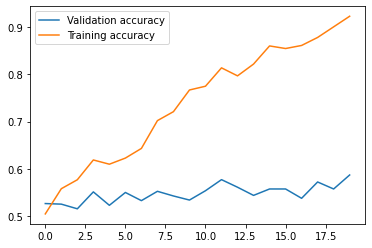
The model stabilized at at accuracy of around 55-58% during training. This is a significant improvement from baseline, which is 50%. There does to appear to be overfitting, as the training accuracy tends to be about became significantly higher than the validation accuracy as the amount of epochs increased.
Data Augmentation
Let’s try to improve upon our first model by augmenting the amount of data that is supplied to train the model. Two ways that we can augment data for images would be by rotating or flipping the image. This would allow the model to find invariant features of the input image. Let’s try out some functions to flip and rotate the images below.
plt.imshow(image[0] / 255.0)
plt.show()
# try one flip
flip1 = layers.RandomFlip()(image[0] / 255.0)
plt.imshow(flip1)
plt.show()
# try another flip
flip2 = layers.RandomFlip()(image[0] / 255.0)
plt.imshow(flip2)
plt.show()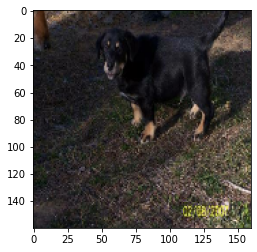
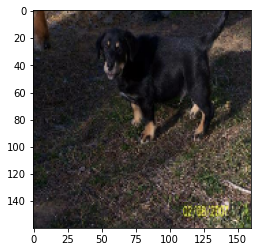
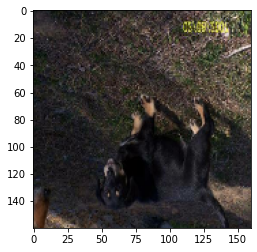
plt.imshow(image[0]/ 255.0)
plt.show()
# try one rotation
rot1 = layers.RandomRotation(90)(image[0] / 255.0)
plt.imshow(rot1)
plt.show()
# try another rotation
rot2 = layers.RandomRotation(180)(image[0] / 255.0)
plt.imshow(rot2)
plt.show()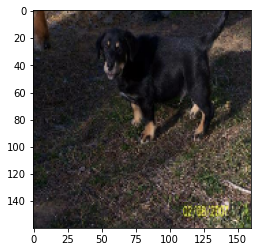
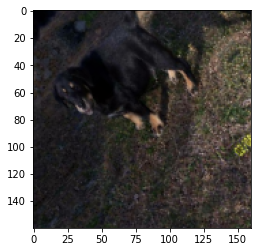
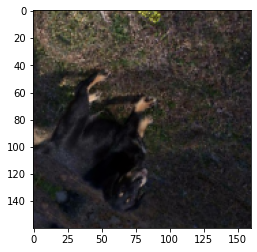
Now that we understand how RandomFlip and RandomRotation work, we can add them as layers to our model. Let’s see how this changes the performance.
model2 = models.Sequential([
layers.RandomFlip("horizontal"),
layers.RandomRotation(30),
layers.Conv2D(32, (3, 3), activation='relu', input_shape=(160, 160, 3)),
layers.MaxPooling2D((3, 3)),
layers.Conv2D(32, (3, 3), activation='relu'),
layers.MaxPooling2D((2, 2)),
layers.Conv2D(64, (3, 3), activation='relu'),
layers.Flatten(),
layers.Dense(64, activation='relu'),
layers.Dropout(0.2),
layers.Dense(2)
])model2.compile(optimizer='adam',
loss = tf.keras.losses.SparseCategoricalCrossentropy(from_logits=True),
metrics = ['accuracy'])
history = model2.fit(train_dataset,
epochs=20,
validation_data=validation_dataset)Epoch 1/20WARNING:tensorflow:Using a while_loop for converting RngReadAndSkip cause there is no registered converter for this op.
WARNING:tensorflow:Using a while_loop for converting Bitcast cause there is no registered converter for this op.
WARNING:tensorflow:Using a while_loop for converting Bitcast cause there is no registered converter for this op.
WARNING:tensorflow:Using a while_loop for converting StatelessRandomUniformV2 cause there is no registered converter for this op.
WARNING:tensorflow:Using a while_loop for converting ImageProjectiveTransformV3 cause there is no registered converter for this op.
WARNING:tensorflow:Using a while_loop for converting RngReadAndSkip cause there is no registered converter for this op.
WARNING:tensorflow:Using a while_loop for converting Bitcast cause there is no registered converter for this op.
WARNING:tensorflow:Using a while_loop for converting Bitcast cause there is no registered converter for this op.
WARNING:tensorflow:Using a while_loop for converting StatelessRandomUniformV2 cause there is no registered converter for this op.
WARNING:tensorflow:Using a while_loop for converting ImageProjectiveTransformV3 cause there is no registered converter for this op.
WARNING:tensorflow:Using a while_loop for converting RngReadAndSkip cause there is no registered converter for this op.
WARNING:tensorflow:Using a while_loop for converting Bitcast cause there is no registered converter for this op.
WARNING:tensorflow:Using a while_loop for converting Bitcast cause there is no registered converter for this op.
WARNING:tensorflow:Using a while_loop for converting StatelessRandomUniformV2 cause there is no registered converter for this op.
WARNING:tensorflow:Using a while_loop for converting ImageProjectiveTransformV3 cause there is no registered converter for this op.63/63 [==============================] - 23s 139ms/step - loss: 21.8647 - accuracy: 0.5165 - val_loss: 0.6957 - val_accuracy: 0.5223
Epoch 2/20
63/63 [==============================] - 8s 118ms/step - loss: 0.6935 - accuracy: 0.4910 - val_loss: 0.6887 - val_accuracy: 0.5396
Epoch 3/20
63/63 [==============================] - 8s 130ms/step - loss: 0.6884 - accuracy: 0.5320 - val_loss: 0.6866 - val_accuracy: 0.5446
Epoch 4/20
63/63 [==============================] - 9s 132ms/step - loss: 0.6902 - accuracy: 0.5215 - val_loss: 0.6899 - val_accuracy: 0.5322
Epoch 5/20
63/63 [==============================] - 7s 115ms/step - loss: 0.6887 - accuracy: 0.5460 - val_loss: 0.6902 - val_accuracy: 0.5483
Epoch 6/20
63/63 [==============================] - 8s 130ms/step - loss: 0.6813 - accuracy: 0.5770 - val_loss: 0.6838 - val_accuracy: 0.5780
Epoch 7/20
63/63 [==============================] - 9s 144ms/step - loss: 0.6767 - accuracy: 0.5675 - val_loss: 0.6787 - val_accuracy: 0.5780
Epoch 8/20
63/63 [==============================] - 8s 116ms/step - loss: 0.6754 - accuracy: 0.5575 - val_loss: 0.6897 - val_accuracy: 0.5297
Epoch 9/20
63/63 [==============================] - 8s 120ms/step - loss: 0.6772 - accuracy: 0.5710 - val_loss: 0.6714 - val_accuracy: 0.5965
Epoch 10/20
63/63 [==============================] - 8s 129ms/step - loss: 0.6681 - accuracy: 0.5960 - val_loss: 0.6803 - val_accuracy: 0.5941
Epoch 11/20
63/63 [==============================] - 8s 130ms/step - loss: 0.6862 - accuracy: 0.5585 - val_loss: 0.6922 - val_accuracy: 0.5149
Epoch 12/20
63/63 [==============================] - 7s 115ms/step - loss: 0.6825 - accuracy: 0.5505 - val_loss: 0.6913 - val_accuracy: 0.5557
Epoch 13/20
63/63 [==============================] - 8s 126ms/step - loss: 0.6833 - accuracy: 0.5405 - val_loss: 0.6998 - val_accuracy: 0.5396
Epoch 14/20
63/63 [==============================] - 8s 130ms/step - loss: 0.6875 - accuracy: 0.5475 - val_loss: 0.6902 - val_accuracy: 0.5421
Epoch 15/20
63/63 [==============================] - 7s 115ms/step - loss: 0.6868 - accuracy: 0.5420 - val_loss: 0.7042 - val_accuracy: 0.5458
Epoch 16/20
63/63 [==============================] - 8s 131ms/step - loss: 0.6746 - accuracy: 0.5680 - val_loss: 0.6999 - val_accuracy: 0.5668
Epoch 17/20
63/63 [==============================] - 8s 131ms/step - loss: 0.6813 - accuracy: 0.5510 - val_loss: 0.6944 - val_accuracy: 0.5718
Epoch 18/20
63/63 [==============================] - 9s 142ms/step - loss: 0.6694 - accuracy: 0.5925 - val_loss: 0.6851 - val_accuracy: 0.5619
Epoch 19/20
63/63 [==============================] - 8s 116ms/step - loss: 0.6743 - accuracy: 0.5900 - val_loss: 0.6799 - val_accuracy: 0.5854
Epoch 20/20
63/63 [==============================] - 8s 131ms/step - loss: 0.6664 - accuracy: 0.5795 - val_loss: 0.6881 - val_accuracy: 0.5854# plot validation and training accuracy
plt.plot(history.history['val_accuracy'], label='Validation accuracy')
plt.plot(history.history['accuracy'], label='Training accuracy')
plt.legend()
plt.show()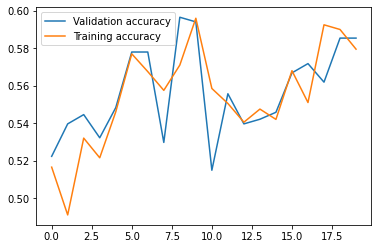
The validation accuracy stabilized around 56-58% during training. This is slightly better than what was obtained in model 1. Additionally, the model does not appear to be overfit, as the training and validation accuracies are mostly similar.
Adding a Preprocessing Step
In order to further improve this model, we can also add a preprocessing step. The original data values had the pixels with RGB values between 0 and 255. However, if we normalize the RGB values so that they range from 0 to 1, the model could focus more on trying to identify the features that distinguish the two classes, rather than adjusting for the scaling. Let’s see how preprocessing changes performance.
i = tf.keras.Input(shape=(160, 160, 3))
x = tf.keras.applications.mobilenet_v2.preprocess_input(i)
preprocessor = tf.keras.Model(inputs = [i], outputs = [x])
model3 = models.Sequential([
preprocessor,
layers.RandomFlip("horizontal"),
layers.RandomRotation(30),
layers.Conv2D(32, (3, 3), activation='relu', input_shape=(160, 160, 3)),
layers.MaxPooling2D((3, 3)),
layers.Conv2D(32, (3, 3), activation='relu'),
layers.MaxPooling2D((2, 2)),
layers.Conv2D(64, (3, 3), activation='relu'),
layers.Flatten(),
layers.Dense(64, activation='relu'),
layers.Dropout(0.1),
layers.Dense(2)
])WARNING:tensorflow:Using a while_loop for converting RngReadAndSkip cause there is no registered converter for this op.
WARNING:tensorflow:Using a while_loop for converting Bitcast cause there is no registered converter for this op.
WARNING:tensorflow:Using a while_loop for converting Bitcast cause there is no registered converter for this op.
WARNING:tensorflow:Using a while_loop for converting StatelessRandomUniformV2 cause there is no registered converter for this op.
WARNING:tensorflow:Using a while_loop for converting ImageProjectiveTransformV3 cause there is no registered converter for this op.model3.compile(optimizer='adam',
loss = tf.keras.losses.SparseCategoricalCrossentropy(from_logits=True),
metrics = ['accuracy'])
history = model3.fit(train_dataset,
epochs=20,
validation_data=validation_dataset)Epoch 1/20WARNING:tensorflow:Using a while_loop for converting RngReadAndSkip cause there is no registered converter for this op.
WARNING:tensorflow:Using a while_loop for converting Bitcast cause there is no registered converter for this op.
WARNING:tensorflow:Using a while_loop for converting Bitcast cause there is no registered converter for this op.
WARNING:tensorflow:Using a while_loop for converting StatelessRandomUniformV2 cause there is no registered converter for this op.
WARNING:tensorflow:Using a while_loop for converting ImageProjectiveTransformV3 cause there is no registered converter for this op.
WARNING:tensorflow:Using a while_loop for converting RngReadAndSkip cause there is no registered converter for this op.
WARNING:tensorflow:Using a while_loop for converting Bitcast cause there is no registered converter for this op.
WARNING:tensorflow:Using a while_loop for converting Bitcast cause there is no registered converter for this op.
WARNING:tensorflow:Using a while_loop for converting StatelessRandomUniformV2 cause there is no registered converter for this op.
WARNING:tensorflow:Using a while_loop for converting ImageProjectiveTransformV3 cause there is no registered converter for this op.63/63 [==============================] - 11s 130ms/step - loss: 0.7200 - accuracy: 0.5520 - val_loss: 0.6747 - val_accuracy: 0.5866
Epoch 2/20
63/63 [==============================] - 7s 114ms/step - loss: 0.6771 - accuracy: 0.5830 - val_loss: 0.6438 - val_accuracy: 0.5990
Epoch 3/20
63/63 [==============================] - 9s 142ms/step - loss: 0.6427 - accuracy: 0.6305 - val_loss: 0.6340 - val_accuracy: 0.6423
Epoch 4/20
63/63 [==============================] - 8s 128ms/step - loss: 0.6482 - accuracy: 0.6290 - val_loss: 0.6398 - val_accuracy: 0.6485
Epoch 5/20
63/63 [==============================] - 7s 114ms/step - loss: 0.6090 - accuracy: 0.6745 - val_loss: 0.6078 - val_accuracy: 0.6597
Epoch 6/20
63/63 [==============================] - 8s 114ms/step - loss: 0.6035 - accuracy: 0.6675 - val_loss: 0.6018 - val_accuracy: 0.6671
Epoch 7/20
63/63 [==============================] - 8s 127ms/step - loss: 0.5919 - accuracy: 0.6790 - val_loss: 0.5797 - val_accuracy: 0.7017
Epoch 8/20
63/63 [==============================] - 8s 118ms/step - loss: 0.5999 - accuracy: 0.6845 - val_loss: 0.5618 - val_accuracy: 0.7178
Epoch 9/20
63/63 [==============================] - 8s 120ms/step - loss: 0.5676 - accuracy: 0.7025 - val_loss: 0.5414 - val_accuracy: 0.7265
Epoch 10/20
63/63 [==============================] - 8s 128ms/step - loss: 0.5508 - accuracy: 0.7145 - val_loss: 0.5528 - val_accuracy: 0.7203
Epoch 11/20
63/63 [==============================] - 9s 147ms/step - loss: 0.5547 - accuracy: 0.7145 - val_loss: 0.5415 - val_accuracy: 0.7203
Epoch 12/20
63/63 [==============================] - 7s 114ms/step - loss: 0.5498 - accuracy: 0.7120 - val_loss: 0.5402 - val_accuracy: 0.7314
Epoch 13/20
63/63 [==============================] - 8s 129ms/step - loss: 0.5476 - accuracy: 0.7200 - val_loss: 0.5388 - val_accuracy: 0.7475
Epoch 14/20
63/63 [==============================] - 8s 129ms/step - loss: 0.5428 - accuracy: 0.7200 - val_loss: 0.5418 - val_accuracy: 0.7277
Epoch 15/20
63/63 [==============================] - 9s 139ms/step - loss: 0.5279 - accuracy: 0.7335 - val_loss: 0.5775 - val_accuracy: 0.7116
Epoch 16/20
63/63 [==============================] - 8s 127ms/step - loss: 0.5294 - accuracy: 0.7185 - val_loss: 0.5155 - val_accuracy: 0.7450
Epoch 17/20
63/63 [==============================] - 8s 129ms/step - loss: 0.5158 - accuracy: 0.7550 - val_loss: 0.5160 - val_accuracy: 0.7525
Epoch 18/20
63/63 [==============================] - 8s 129ms/step - loss: 0.5175 - accuracy: 0.7385 - val_loss: 0.5329 - val_accuracy: 0.7463
Epoch 19/20
63/63 [==============================] - 7s 112ms/step - loss: 0.5070 - accuracy: 0.7555 - val_loss: 0.5097 - val_accuracy: 0.7463
Epoch 20/20
63/63 [==============================] - 8s 128ms/step - loss: 0.5007 - accuracy: 0.7425 - val_loss: 0.5177 - val_accuracy: 0.7426# plot validation and training accuracy
plt.plot(history.history['val_accuracy'], label='Validation accuracy')
plt.plot(history.history['accuracy'], label='Training accuracy')
plt.legend()
plt.show()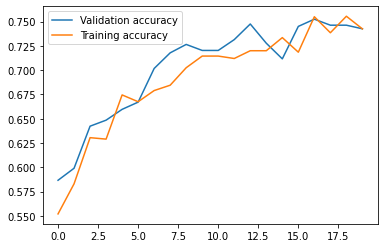
The validation accuracy stabilized around 73-74% during training. This is a significant improvement from what was obtained in model 1. The model also does not appear to be overfit, as the training and validation accuracies are similar.
Using Transfer Learning
Although we have achieved a model that can perform above baseline by creating a model from scratch, we could create a much better performing model by using a pre-trained model. In this example we wil use MobileNetV2, a model which has been trained for image classification, as a base layer for our model. We can use the code below to download MobileNetV2 and configure it as a layer.
IMG_SIZE = (160, 160)
i = tf.keras.Input(shape=(160, 160, 3))
x = tf.keras.applications.mobilenet_v2.preprocess_input(i)
preprocessor = tf.keras.Model(inputs = [i], outputs = [x])
IMG_SHAPE = IMG_SIZE + (3,)
base_model = tf.keras.applications.MobileNetV2(input_shape=IMG_SHAPE,
include_top=False,
weights='imagenet')
base_model.trainable = False
i = tf.keras.Input(shape=IMG_SHAPE)
x = base_model(i, training = False)
base_model_layer = tf.keras.Model(inputs = [i], outputs = [x])Downloading data from https://storage.googleapis.com/tensorflow/keras-applications/mobilenet_v2/mobilenet_v2_weights_tf_dim_ordering_tf_kernels_1.0_160_no_top.h5
9406464/9406464 [==============================] - 0s 0us/stepNow that the layer has been created, let’s put this into a model. We will still use our data augmentation techniques, GlobalAveragePooling2D, Dropout, and Dense in addition to the pre-trained base layer that we downloaded. There is also a summary of the model so that we can vizualise the layers in the model.
model4 = models.Sequential([
preprocessor,
layers.RandomFlip("horizontal"),
layers.RandomRotation(180),
base_model_layer,
layers.GlobalAveragePooling2D(),
layers.Dropout(0.2),
layers.Dense(2)
])
model4.summary()WARNING:tensorflow:Using a while_loop for converting RngReadAndSkip cause there is no registered converter for this op.
WARNING:tensorflow:Using a while_loop for converting Bitcast cause there is no registered converter for this op.
WARNING:tensorflow:Using a while_loop for converting Bitcast cause there is no registered converter for this op.
WARNING:tensorflow:Using a while_loop for converting StatelessRandomUniformV2 cause there is no registered converter for this op.
WARNING:tensorflow:Using a while_loop for converting ImageProjectiveTransformV3 cause there is no registered converter for this op.Model: "sequential_4"
_________________________________________________________________
Layer (type) Output Shape Param #
=================================================================
model (Functional) (None, 160, 160, 3) 0
random_flip_3 (RandomFlip) (None, 160, 160, 3) 0
random_rotation_3 (RandomRo (None, 160, 160, 3) 0
tation)
model_1 (Functional) (None, 5, 5, 1280) 2257984
global_average_pooling2d_3 (None, 1280) 0
(GlobalAveragePooling2D)
dropout_4 (Dropout) (None, 1280) 0
dense_4 (Dense) (None, 2) 2562
=================================================================
Total params: 2,260,546
Trainable params: 2,562
Non-trainable params: 2,257,984
_________________________________________________________________model4.compile(optimizer='adam',
loss = tf.keras.losses.SparseCategoricalCrossentropy(from_logits=True),
metrics = ['accuracy'])
history = model4.fit(train_dataset,
epochs=20,
validation_data=validation_dataset)Epoch 1/20WARNING:tensorflow:Using a while_loop for converting RngReadAndSkip cause there is no registered converter for this op.
WARNING:tensorflow:Using a while_loop for converting Bitcast cause there is no registered converter for this op.
WARNING:tensorflow:Using a while_loop for converting Bitcast cause there is no registered converter for this op.
WARNING:tensorflow:Using a while_loop for converting StatelessRandomUniformV2 cause there is no registered converter for this op.
WARNING:tensorflow:Using a while_loop for converting ImageProjectiveTransformV3 cause there is no registered converter for this op.
WARNING:tensorflow:Using a while_loop for converting RngReadAndSkip cause there is no registered converter for this op.
WARNING:tensorflow:Using a while_loop for converting Bitcast cause there is no registered converter for this op.
WARNING:tensorflow:Using a while_loop for converting Bitcast cause there is no registered converter for this op.
WARNING:tensorflow:Using a while_loop for converting StatelessRandomUniformV2 cause there is no registered converter for this op.
WARNING:tensorflow:Using a while_loop for converting ImageProjectiveTransformV3 cause there is no registered converter for this op.63/63 [==============================] - 14s 140ms/step - loss: 0.3827 - accuracy: 0.8285 - val_loss: 0.1085 - val_accuracy: 0.9666
Epoch 2/20
63/63 [==============================] - 9s 141ms/step - loss: 0.2490 - accuracy: 0.8970 - val_loss: 0.0744 - val_accuracy: 0.9777
Epoch 3/20
63/63 [==============================] - 9s 141ms/step - loss: 0.2225 - accuracy: 0.9115 - val_loss: 0.0667 - val_accuracy: 0.9765
Epoch 4/20
63/63 [==============================] - 10s 150ms/step - loss: 0.2077 - accuracy: 0.9115 - val_loss: 0.0751 - val_accuracy: 0.9728
Epoch 5/20
63/63 [==============================] - 8s 129ms/step - loss: 0.2075 - accuracy: 0.9160 - val_loss: 0.0666 - val_accuracy: 0.9740
Epoch 6/20
63/63 [==============================] - 10s 156ms/step - loss: 0.2073 - accuracy: 0.9145 - val_loss: 0.0686 - val_accuracy: 0.9715
Epoch 7/20
63/63 [==============================] - 13s 200ms/step - loss: 0.1973 - accuracy: 0.9190 - val_loss: 0.0645 - val_accuracy: 0.9790
Epoch 8/20
63/63 [==============================] - 9s 142ms/step - loss: 0.1759 - accuracy: 0.9320 - val_loss: 0.0769 - val_accuracy: 0.9678
Epoch 9/20
63/63 [==============================] - 10s 155ms/step - loss: 0.1919 - accuracy: 0.9210 - val_loss: 0.0722 - val_accuracy: 0.9752
Epoch 10/20
63/63 [==============================] - 8s 125ms/step - loss: 0.1714 - accuracy: 0.9315 - val_loss: 0.0646 - val_accuracy: 0.9777
Epoch 11/20
63/63 [==============================] - 10s 146ms/step - loss: 0.1715 - accuracy: 0.9325 - val_loss: 0.0642 - val_accuracy: 0.9802
Epoch 12/20
63/63 [==============================] - 10s 150ms/step - loss: 0.1726 - accuracy: 0.9260 - val_loss: 0.0668 - val_accuracy: 0.9740
Epoch 13/20
63/63 [==============================] - 10s 149ms/step - loss: 0.1676 - accuracy: 0.9335 - val_loss: 0.0656 - val_accuracy: 0.9765
Epoch 14/20
63/63 [==============================] - 10s 159ms/step - loss: 0.1740 - accuracy: 0.9315 - val_loss: 0.0679 - val_accuracy: 0.9765
Epoch 15/20
63/63 [==============================] - 8s 127ms/step - loss: 0.1563 - accuracy: 0.9365 - val_loss: 0.0708 - val_accuracy: 0.9691
Epoch 16/20
63/63 [==============================] - 10s 150ms/step - loss: 0.1687 - accuracy: 0.9335 - val_loss: 0.0654 - val_accuracy: 0.9790
Epoch 17/20
63/63 [==============================] - 10s 152ms/step - loss: 0.1690 - accuracy: 0.9340 - val_loss: 0.0580 - val_accuracy: 0.9814
Epoch 18/20
63/63 [==============================] - 9s 139ms/step - loss: 0.1586 - accuracy: 0.9380 - val_loss: 0.0653 - val_accuracy: 0.9765
Epoch 19/20
63/63 [==============================] - 8s 125ms/step - loss: 0.1615 - accuracy: 0.9390 - val_loss: 0.0738 - val_accuracy: 0.9728
Epoch 20/20
63/63 [==============================] - 13s 202ms/step - loss: 0.1636 - accuracy: 0.9305 - val_loss: 0.0758 - val_accuracy: 0.9715# plot validation and training accuracy
plt.plot(history.history['val_accuracy'], label='Validation accuracy')
plt.plot(history.history['accuracy'], label='Training accuracy')
plt.legend()
plt.show()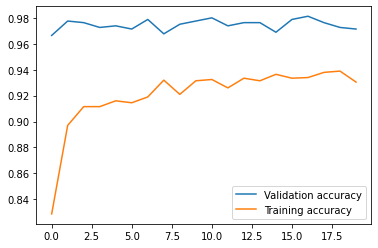
The validation accuracy stabilized around 97% during training. This is a a stark improvement from what was obtained in model 1, as the classifier went from slightly better than baseline to near perfect. The model also does not appear to be overfit, as the training accuracy is actually lower than the validation accuracy for all of the epochs.
This model seems to perform very well. Let’s see how it performs on unseen test data.
# Score on test data
loss, acc = model4.evaluate(test_dataset)
print('Test accuracy:', acc)6/6 [==============================] - 0s 41ms/step - loss: 0.0762 - accuracy: 0.9740
Test accuracy: 0.9739583134651184The test accuracy is very high at 97.3%, meaning that our classifier performs very well. Congrats, we have successfully made an image classifier that can differentiate between cats and dogs!